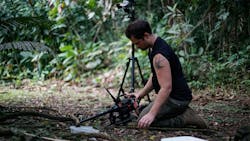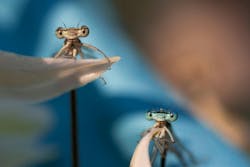Inside the Macroworld of National Geographic’s “A Real Bug’s Life 2”
What you’ll learn:
- How National Geographic filmed “A Real Bug’s Life Season 2.”
- The technology used to capture those stunning images and video.
- How that tech was applied to create the vivid insect worlds.
National Geographic is set to release its highly anticipated docuseries sequel, “A Real Bug’s Life Season 2.” The latest venture takes views back into the macroworld of bugs in their natural habitats from all around the globe, with intimate looks at different miniature creatures and how the forces of nature play out within those tiny worlds.
“A Real Bug’s Life Season 2” uses new and repurposed technology to get an intimate view of insects in the hidden world. Among the up-close looks are a fast-legged tiger beetle looking to beat the heat of Malaysia’s beaches, the metamorphosis of a damselfly on a British pond, and a Smoky Mountain luna moth whose short life revolves around growing wings and finding a mate to pass on his genes in the span of an evening.
The sequel offers the same beautiful cinematography as shown in Season 1, which relies on the skills and expertise of a host of professionals, from entomologists well-versed on creatures in local environments to camera operators using a wide range of lenses to capture the magic of insects going about their daily lives. The logistics involved in filming on location are astounding and require more than just khaki clothes, boonie hats and cameras.
Getting close and personal requires innovative ways to capture video and images without disturbing the insects. Their natural instincts are to run and hide if they feel threatened or their environments are disturbed.
“Though this is not too unlike what we did in Season 1. In the second season, we employed technology which is cutting-edge for microfilming, doing novel things that allowed us to get the behavior of bugs that filmmakers of the past struggled to film in a natural environment,” stated Producer Rob Morgan.
Innovative Imaging Systems
To capture those incredible shots, the camera team took advantage of the latest imaging tech and some subtle tricks to get the insects to behave naturally with little interference. Capturing insects in the wild on film is difficult at best. They don’t follow scripts and do anything else besides what the camera operator wants them to perform. So, setting up those shots needs some finesse, such as doping flowers with sugar water to capture a video of a butterfly or enticing a spider with a live meal.
Getting in close requires specialized imaging and camera equipment, including Laowa macro-probes that allow users to broach difficult-to-reach areas, such as underbrush and hollowed-out logs. These have a focus of about 2:1 to infinity, depending on the probe, and some models are waterproof, allowing for their use in humid and aquatic environments.
Camera operator for the series, Chris Watts, created an imaging system smaller than the Loawa probes for up-close shots, which is a little bigger than a hypodermic needle and can be outfitted with lenses so small that even tiny spiderlings seem giant in comparison. Camera operators even repurposed medical endoscopes (Fig. 1), which enabled them to place the tiny imaging system at ground level and capture never-before-seen details of insect behavior and anatomy.
Cameras can also have adverse effects on insects when it comes to lighting and filming in low-light conditions, as lighting often generates noticeable heat. That was a concern for the camera crew, so they came up with a novel solution.
“Our lenses are LED. Given that LEDs achieve proper brightness with less heat, the bugs behaved naturally when we filmed them,” said Nathan Small, Director of Photography. “This is unlike the hotter tungsten lights used in the past. What's more, in older documentaries about insects, you'll often see 45-degree angles, but because of our novel use of technology, we didn’t have to do that—we literally got at eye level with bugs, which is a rare and remarkable accomplishment.”
The camera team also used tiny racing drones outfitted with macro lenses to capture insects in flight, and low-light cameras for filming in darkness. Furthermore, a motion-controlled camera system, controlled using a Play Station 4 controller, captured fluidity at a macro level in many different angles.
Photogrammetry and Focus Stacking
Photogrammetry and focus stacking also played a huge role in “A Real Bug’s Life Season 2.” Photogrammetry is a relatively new technique that uses photographs to create 3D models of objects, spaces, structures, and even digital twins. The technique works by utilizing algorithms to stitch together overlapping photos, creating point clouds using different positions and colors in the images, and then connecting the points to make a detailed mesh of the objects or environment.
Another imaging technique implemented for the series was focus stacking (Fig. 2). It involves combining multiple photos taken at different focus distances to create a single image with a greater depth of field. Algorithms are used to blend the images together. When both processes are combined, it creates a level of realism never before seen in macro imaging, bringing to life tiny worlds and the insects that live in them.
Overcoming Filming Challenges
Season 2 wasn’t without its challenges. Filming tiny insects isn’t an easy endeavor; they typically want to hide or flee at the sight of humans and their technology.
“In the episode ‘Tiny Heroes Down Under,’ we filmed the smallest bug, which is the peacock spider. Upon hatching, they're only 1 mm, the size of a grain of sand, if even that; hence, they were extremely hard to keep track of,” said Morgan.
Insect populations are also on the decline worldwide, with some that could go extinct just from a forest fire or other natural disaster. This could pose a challenge if National Geographic wants to create a third season of “A Real Bug’s Life.”
Of course, all of that technology is used to capture thousands of images and videos that are put together by teams of engineers to create the incredible visuals of all five episodes in the latest series. They were shot in both the wild and in controlled environments that merge new imaging techniques and systems with repurposed hardware and innovation. The result is an incredible journey with beautiful views of insects at their level and their perspective of the intriguing micro-worlds around them.
“A Real Bug’s Life Season 2” is set to stream on Disney+ beginning Wednesday, January 15th.



